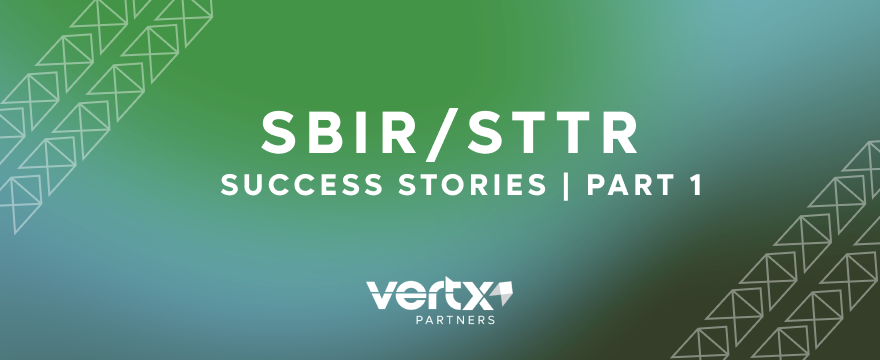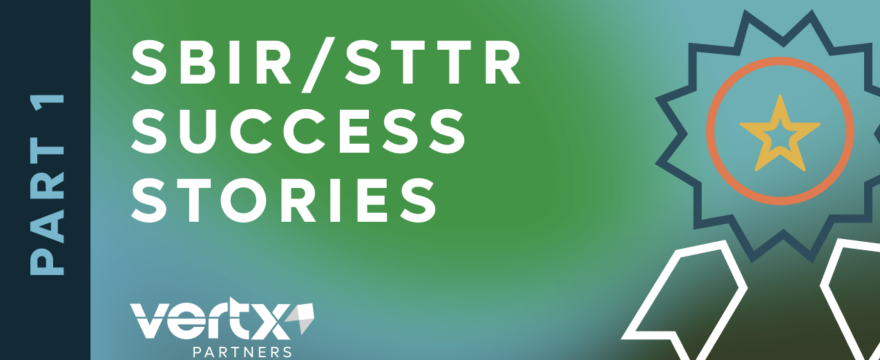SBIR/STTR success stories are all around us. In this guide, we showcase a few examples where small businesses benefited from federal funding.

At Vertx Partners, seeing is believing. Platitudes and promises of success are one thing – real-world success stories where ideas have come to life are another. Our guide on SBIR/STTR award impacts on communities highlighted several startups that benefited from federal funding. This guide will explore a few more.
This guide is also the first in a series that will inform and inspire. This series will examine businesses and research institutions that have reaped the rewards of federal contracting. Every year, more and more success stories come out of businesses and their partners utilizing the Small Business Innovation Research (SBIR)/Small Business Technology Transfer (STTR) awards to innovate and even change the world.
Here are our first five SBIR/STTR success stories:
1. SubUAS, LLC
SubUAS has conquered the air and sea with an ingenious invention: the cleverly named Naviator platform. The Naviator is essentially a drone like any Unmanned Aerial System (UAS), but with the unique ability to operate underwater and in the air. Not only can this device operate in both environments: it can do so seamlessly. This is quite literally a drone that transfers from water to air and vice versa in less than a second.
SubUAS was able to realize its Naviator platform with the help of an STTR award grant. With this grant, they worked with researchers at Rutgers University, amassing a pool of resources previously inaccessible to both partners separately. The Naviator system has been so successful that SubUAS has been awarded a rare Phase III contract valued at around $4 million. Their client is the U.S. Navy itself.
2. COnovate, Inc. (formerly SafeLi, LLC)
Carbon monoxide (CO): a colorless, odorless gas with a deadly reputation. But did you know it may play a role in the coming energy revolution? Two physicists at the University of Wisconsin-Milwaukee recently discovered solid carbon monoxide, the first known form of its kind. It’s called Graphene Monoxide (GmO). Its molecular structure makes it perfect for use in lithium-ion batteries. This structure makes the batteries charge faster, hold a charge longer, and operate safer.
After the discovery of Graphene Monoxide, the two physicists patented the technology and started COnovate, Inc. (formerly SafeLi, LLC) with the help of SBIR and STTR funding. These awards came from the National Science Foundation (NSF) and the Department of Energy (DoE), helping COnovate accelerate research and development to bring their discovery to the market. Without this early funding, it’s likely their discovery would have languished with little interest in commercial scalability.
3. Endurica, LLC
The rubber industry has for years used the tried-and-true method of trial-and-error to test their rubber products. The technique works well but introduces several safety risks, time delays, and additional manufacturing costs. Endurica’s founder saw that the rubber industry was working harder, not smarter, with its testing processes and sought to close the gap between theoretical and applied knowledge of rubber products. His company patented software that combines knowledge assessed in advanced materials testing with computer simulations that accurately and reliably show manufacturers the lifespan of their products.
Now, automotive, defense, and consumer product companies worldwide use his software.
With a Department of Defense SBIR, Endurica could test its predictions in the real-world application of rubber track pads on Abrams tanks. The funding also streamlined the R&D process, enabling them to go global with their product. They now serve half of the world’s top twelve rubber producers.
4. Braxton Technologies, LLC
Braxton Technologies has a long, storied history with the SBIR/STTR program, becoming a flagship for the initiative and a textbook case study into how the program generates widespread benefit. Since its involvement in the program in 2013, the company has been awarded three Phase III awards for its software governing space operations and weapon systems, more than quadrupling the company’s revenue in less than a decade.
SBIR and STTR awards allowed the company to convincingly demonstrate the feasibility and capability of its immensely successful technologies, utilizing resources exclusive to federal agencies that ensured Braxton Technologies’ systems would hold up in the real world. The SBIR/STTR program also helped Braxton Technologies build lasting connections with defense industry insiders, which it continues to work with to this day.
5. Blackbox Biometrics, Inc.
Hidden within the cranium, the brain is a delicate organ that is notoriously difficult to assess medically. Blackbox Biometrics developed the Blast Gauge, a small device worn by participants in combat scenarios that measures ballistic force and cues medics on when warfighters should be taken in for medical treatment. Their initial tests indicated that low-level blasts below the sensitivity of the Blast Gauge added up to the same level of damage as one singular, high-powered blast.
The Blast Gauge needed more research to boost its sensitivity, so Blackbox Biometrics acquired an SBIR grant from the DoD, increasing the device’s accuracy and adding wireless transmitting capabilities. Now, Blackbox Biometrics sells its Blast Gauges on a massive scale to all departments of the DoD, law enforcement operations, and some foreign powers. With over 600,000 units sold, the Blast Gauge has saved countless lives by making brain trauma assessment easier.
These are just five examples of SBIR/STTR success stories. As you can see, each business has made its mark in several ways, whether through advanced materials, software, energy, or robotics.
Vertx Partners will continue to tell stories of small businesses making significant strides with SBIR/STTR funding. Inspired by what you see here? Contact Vertx Partners today with our 6-minute survey, and one of our experts will be in touch within 48 hours.
Become an Innovator With Us
Tell us about yourself, answer a few questions, and hit submit. It’s as easy as that to get started.
